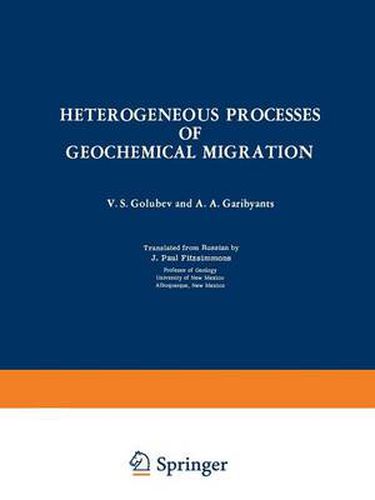Readings Newsletter
Become a Readings Member to make your shopping experience even easier.
Sign in or sign up for free!
You’re not far away from qualifying for FREE standard shipping within Australia
You’ve qualified for FREE standard shipping within Australia
The cart is loading…






This title is printed to order. This book may have been self-published. If so, we cannot guarantee the quality of the content. In the main most books will have gone through the editing process however some may not. We therefore suggest that you be aware of this before ordering this book. If in doubt check either the author or publisher’s details as we are unable to accept any returns unless they are faulty. Please contact us if you have any questions.
The problem of the geochemical migration of elements has received wide attention in the works of V. I. Vernadskii and A. E. Fersman [1, 2J. Vernadskii considered geochemistry to be the science of the history of chemical elements on the earth, their distribution and move ments in space and time, and their genetic relations [IJ. Geochemical migration was defined by Fersman as the movement of chemical elements in the earth’s crust leading to their dissemination or concentration.
The views of Vernadskii and Fersman on the migration of elements have received added support and development in connection with successes in physics, chemistry, biology, and other sciences. According to Fersman, the earth is looked upon as a cosmic body, characterized by common origin and Similarity of composition with the sun, the planets, meteorites, and other bodies of the solar system. The scale and trend of geochemical migration of elements in the earth are determined by the initial state of terrestrial matter, its thermal history, and the scale of time. The rules of elemental migration are determined by internal and exterual fac tors. Fersman distinguishes five groups of internal factors, i. e.
$9.00 standard shipping within Australia
FREE standard shipping within Australia for orders over $100.00
Express & International shipping calculated at checkout
This title is printed to order. This book may have been self-published. If so, we cannot guarantee the quality of the content. In the main most books will have gone through the editing process however some may not. We therefore suggest that you be aware of this before ordering this book. If in doubt check either the author or publisher’s details as we are unable to accept any returns unless they are faulty. Please contact us if you have any questions.
The problem of the geochemical migration of elements has received wide attention in the works of V. I. Vernadskii and A. E. Fersman [1, 2J. Vernadskii considered geochemistry to be the science of the history of chemical elements on the earth, their distribution and move ments in space and time, and their genetic relations [IJ. Geochemical migration was defined by Fersman as the movement of chemical elements in the earth’s crust leading to their dissemination or concentration.
The views of Vernadskii and Fersman on the migration of elements have received added support and development in connection with successes in physics, chemistry, biology, and other sciences. According to Fersman, the earth is looked upon as a cosmic body, characterized by common origin and Similarity of composition with the sun, the planets, meteorites, and other bodies of the solar system. The scale and trend of geochemical migration of elements in the earth are determined by the initial state of terrestrial matter, its thermal history, and the scale of time. The rules of elemental migration are determined by internal and exterual fac tors. Fersman distinguishes five groups of internal factors, i. e.